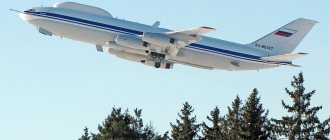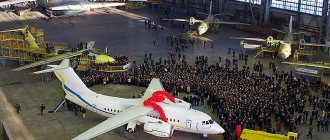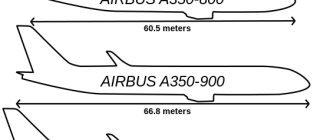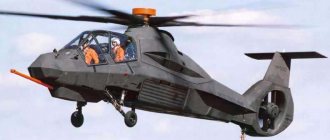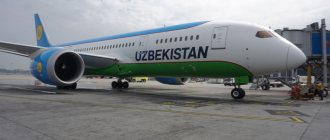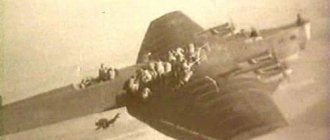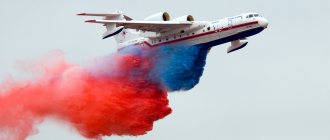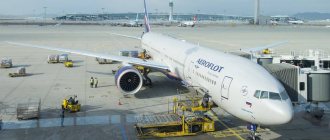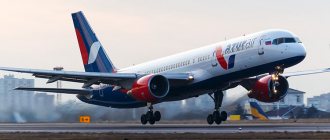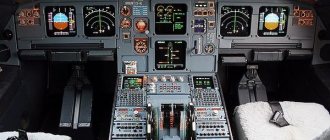| Boeing 707 | |
| Boeing 707-138B Jett Clipper Ella , owned by John Travolta, at the Le Bourget Air Show | |
| Type | Passenger plane |
| Developer | Boeing |
| Manufacturer | Boeing Commercial Airplanes |
| First flight | July 15, 1954 |
| Start of operation | 1958 |
| Status | in operation (155 as of February 2010) |
| Years of production | 1958 — 1978 |
| Units produced | 1 010 |
| Unit cost | 4.3 million (1955) |
| Options | E-3 Sentry E-6 Mercury E-8 JSTARS KC-135 Stratotanker Shanghai Y-10 |
| Images on Wikimedia Commons | |
Boeing 707Boeing 707
Boeing 707
is an American jet four-engine passenger aircraft designed in the early 1950s. One of the first jet passenger airliners in the world, along with the British DH-106 Comet, the Soviet Tu-104 and the French Sud Aviation Caravelle.
The prototype 367-80 made its first flight on July 15, 1954. The first flight of the experimental serial 707-120 took place on December 20, 1954. In total, from 1958 to 1991, 1010 Boeing 707 units of various configurations and modifications were produced. Commercial service of the 707-120 began with Pan American World Airways on October 26, 1958.
The first military transport/tanker aircraft, the KC-135, based on the 367-80 and structural elements of the 707s, took off in August 1956, their deliveries to the US Air Force began in June 1957. Based on the Boeing 707 and KC-135 were their various civil and military modifications have been created: tankers, reconnaissance aircraft, reconnaissance aircraft of the enemy, weather reconnaissance aircraft, aircraft for scientific research, AWACS aircraft, air command posts for control and communications with strategic nuclear forces - ICBMs, submarines with SLBMs, bombers in case of destruction ground command posts in a nuclear war, transportation of senior leadership (USA and other countries).
Currently, Boeing 707 freighters and various military modifications of the Boeing 707 and KC-135 continue to fly and will presumably fly until 2040. They are mainly used in the AWACS electronic reconnaissance system.
Modifications
Serially built and converted aircraft built by Boeing:
- 367-80
- 707-120
- 707-220
- 707-227
- 707-320 Intercontinental
- 707-220B
- 707-320B
- 707-320B Advanced
- 707-320C
- 707-420
- 707-700
- 720
- 720B
Aircraft for transporting senior management:
- The VC-137C is a modification of the Boeing 707-320B for the US Air Force to transport US presidents. 2 aircraft were built - No. SAM26000 in 1962 and No. SAM27000 in 1972. They wore a special paint job. Air traffic control gave them the code Air Force One - the plane the president was on board. Currently, both aircraft have been replaced by 2 VC-25s and 4 C-32s (for vice presidents and other administration civil servants) and are in museums.
Military modifications based on the 707 airframe:
- The E-3 Sentry is a production AWACS aircraft that has a modernized Boeing 707-320 airframe with a radome rotating above the fuselage with a radar antenna. The fairing, 9.1 m in diameter and 1.8 m in thickness, is mounted on two supports at a height of 4.2 m above the fuselage. Low-flying targets can be detected at a distance of 375 km, targets above the horizon - at a distance of 600 km from the aircraft. 2 generators on each of 4 engines produce 1 megawatt of electricity consumed by the locator.
- E-6 Mercury is a serial air command post for control and communication with strategic nuclear forces - ICBMs, submarines with SLBMs, in case of destruction of ground command posts in a nuclear war, having a modernized Boeing 707-320 airframe and 4 CFM-56 engines. They were originally built in the E-6A modification and served only to transmit commands to submarines with SLBMs, which were submerged, using ultra-long wave transmitters and 2 long produced multi-kilometer towed cable antennas (TACAMO program) to replace the obsolete EC-130. Until 1992, at least 2 of the 16 aircraft built were constantly in the air, one over the Atlantic, the other over the Pacific Ocean. Currently they are on duty at 4 bases in readiness for takeoff. Since October 1998, they have been converted to the E-6B variant and also perform the functions of airborne command posts (ABNCP) under a program called “Looking Glass” (“Looking glass”, mirror
) (airborne system reflecting /replicating ground-based systems) to control ICBM launches using the ALCS system. Replaced EC-135s taken off duty in this role. - E-8 JSTARS is a serial aircraft for radar reconnaissance of ground targets on the battlefield and transmission of information to all branches of the US military in real time, having a modernized Boeing 707-320 airframe with a long radome installed under the fuselage along its front part with a fixed radar antenna. The radar can only detect moving radar-observable targets at a distance of 250 km from the side of the flight direction over an area of 50 thousand km² and has a viewing angle of 120°. The aircraft's computers remember and summarize information about all targets that have ever moved on the battlefield. Between 1991 and 2005, 17 aircraft were built.
- S-18 is a military transport cargo modification of the Boeing 707-320B for the US Air Force.
- EC-18B - aircraft for control and measurement during various tests of cruise, anti-aircraft, ballistic missiles, re-entry ballistic missile warheads and spacecraft, created on the basis of modernized Boeing 707-320 airframes. All 8 EC-18Bs were built starting in 1982 from retired civilian aircraft. Similar EC-135N and EC-135E based on the KC-135 began service earlier, in 1960-1970. The aircraft had a 2.1-meter parabolic antenna in a large, visible egg-shaped fairing mounted in front of the cockpit along the axis of the fuselage, offset downwards so as not to block the pilots' view. The antenna served to receive telemetry from the devices being tested. There were optical means of observation and photographic filming of test warheads entering the atmosphere. Currently 3 EC-18Bs are in use.
Other military and research aircraft similar to the Boeing 707 were based on the KC-135 airframe.
Interior layout and seating arrangement
Cabin layout of the B767-300 airline Pegas Fly
With the usual cabin layout of the Boeing 767 300, the seat layout assumes:
- standard division of the cabin into “business” and “economy” zones, where the more expensive part has 12-20 seats, and the cheaper part has 278-288;
- installation of seats in the “economy” zone in a row according to the 2x3x2 principle, in the “business” zone - 2x2x2 to increase the width of the aisle;
- the distance between the seats is up to 57 cm in the economy lounge and 105 cm in the business area;
- use of charter airlines by planes, installation of seats according to a mono-cabin layout with a maximum number of seats (330-350);
- seven bathrooms on board - one at the beginning, two in the middle of the cabin and four at the end.
It is necessary to decide “on shore” which of the qualities of the seats in the aircraft cabin is the most important:
- a set of options that make the flight more comfortable (available only in the business zone);
- more legroom;
- minimal shaking;
- the ability to sit by the window or, conversely, by the aisle.
Now we’ll tell you where the places with certain properties are located.
Boeing 767 cabin, economy class area
Best places
The most comfortable places are located in the business zone, the differences of which are:
- large space between seats;
- entertainment for passengers, charging gadgets available at any time;
- the opportunity to use blankets, pillows, and sleep masks.
Whether it is worth paying extra for comfort by buying more expensive tickets, each passenger decides for himself. Sometimes you can pay for seats in comfort class with accumulated miles under the terms of the airline’s loyalty program.
Those who prefer access to the maximum selection of dishes served for lunch should sit in the business area or at the beginning of the main cabin (passengers at the end and even in the middle of the cabin often lack some dishes).
More legroom for passengers in the first row, as well as in rows 14 (C, D, F), 16 (A, B, G, H), 32 (C, D, E, F) and 33 (A, B, G, H). But, as follows from the Boeing 767 300 diagram, these seats are located in the emergency exit area, so they cannot be occupied by persons with disabilities, passengers with children and/or animals.
Nice places
Side seats are preferred for couples traveling together. With this choice:
- there is access to a porthole, to which you can change seats one by one, by mutual agreement;
- no need to disturb other people to go to the bathroom;
- the couple gets at least a little space separated from the rest of the passengers.
Those who prefer to admire the scenery or relax the whole way without getting up also sit at the portholes.
Aisle seats are only comfortable for those who have to get up frequently during the flight (say, passengers with restless children).
Middle seats are less comfortable due to limited armrests and the need to disturb neighbors if you need to stand up. But of the possible inconveniences, these are not the most significant.
Bad places
As with most airliners, the seats in the rear are the least comfortable to sit in, as the engine noise and vibration are more noticeable.
Seats in the 11th and 27th rows are among the worst due to the proximity of the toilets.
In the 24th, 25th and 38th rows, the backrests of the seats do not recline completely, which makes it difficult to rest in a lying position. There is also reduced space for hand luggage and there is a risk that it will have to be placed at your feet, which is another annoying inconvenience.
Recommended:
- Compare the diagram here with your airline's Boeing seat layout;
- avoid chairs at the end of the compartment - these are where the backrests do not fully recline;
Avoid proximity to toilets.
Operation history
The largest customers of the B-707 were the American PanAm and TWA, thanks to these airliners they rapidly increased the size of their fleets and made international air travel widespread and popular. They were soon joined by Western European airlines. Mass production of the B-707 took place in the 1960s, when customers received dozens of new aircraft every year. The aircraft competed with the DC-8, which was initially more successful due to the better reputation of the manufacturer. After modifications, the Boeing 707 began to sell much better.
With the increase in passenger traffic, it became obvious that the Boeing 707 was obsolete. The aircraft had too small a capacity for its range; its engines were noisy and inefficient. Modernization of the airliner with an increase in capacity required a replacement of the airframe. As a result, Boeing released the Boeing 747 to the market, thereby satisfying the demand for large-capacity aircraft for long-distance flights.
By the early 1970s, the number of orders for the Boeing 707 had dropped sharply. Airlines in developed countries were withdrawing them from their fleet; the activity of aircraft of this type moved to the countries of Asia and Latin America, and then Africa. In 1978, serial production was discontinued; in 1983, the last scheduled flight of the Boeing 707 to the USA took place. The last major operator of passenger Boeing 707s was Lebanon (until 1998). By the early 2000s, the aircraft remained in civilian service (almost exclusively as a cargo carrier), mainly in the poorest countries of Africa and Latin America. The main fleet of currently flying Boeing-707s consists of military modifications.
Many civilian passenger Boeing 707s, having served, were converted into cargo, military and research aircraft, and those that ended up at storage bases now serve as a source of spare parts and engines for all modifications of the 707 and KC-135 currently flying.
Airplane safety
The most dangerous moment during the entire flight of an airliner is takeoff and landing. Weight at takeoff does not significantly affect the characteristics of the vehicle, but is taken into account during takeoff. If there is an overload, then the strip should be significantly longer than with a minimum mass.
Headwind or tailwind during takeoff does not play a special role; only the side wind is taken into account: it should not exceed 19 m/s, otherwise the risk of massive equipment shifting to the side of the runway increases.
Landing weight is very important: the permissible value for the Boeing 737 800 aircraft is 65.3 tons.
At the moment, more than 200 aircraft have been lost. The first disaster occurred in the USA (Philadelphia), the takeoff was canceled by mistake, it was decided that the engines had failed. After this, the tire rolled off the runway.
More than half of the disasters occurred with the Original 100 and 200 family
One of the latest unpleasant events occurred in the United States. During landing, the plane rolled off the runway and slid into the river. Fortunately, no one was hurt.
Current operators
As of the beginning of 2010[1], 155 B-707 aircraft were in use, almost all in the air forces of a number of countries (AWACS and cargo aircraft). Several vehicles are used by civil cargo airlines, 8 by government air squadrons. The last airline to use the B-707 on scheduled passenger flights was Iran's Saha Air, which had 5 aircraft in service as of August 10, 2010. However, since April 2013, the company stopped flying, although it itself still exists. Thus, the Boeing 707 is the last of the first generation jetliners that was in service until recently; other “pioneers” of jet passenger aviation went down in history back in the 80s.
Interior layout and seating arrangement
Let's look at the Boeing 737's cabin layout using the 800NG as an example. The seats are arranged in 6 rows - three each, separated by an aisle. There are three toilets, two of which are located at the rear. There is also a large kitchen there, and another one at the front of the plane, which is smaller. There are two exits in front and two in the back, emergency exits approximately in the middle between the seats for passengers - there are four of them, separated by a row of seats.
Distribution of seats in the cabin
The distribution of seats is as follows:
- Between the front and emergency entrances there are three rows ABC and DEF, separated by an aisle. The first group has 42 chairs, of which 3 with increased legroom, 3 with non-reclining backrests. The second group has 39 seats;
- Between the emergency exits there are 6 more seats with increased legroom;
- In the back there are two identical groups of 51 seats.
Boeing 707 in popular culture
The plane “played” the main role in the films “Airport” (based on the novel of the same name by Arthur Haley) and its parody “Airplane!”
Famous American actor John Travolta has a personal Boeing 707-138B. This aircraft was built in 1964 for the Australian airline Qantas, where it successfully flew until 1969. Then the plane changed owners several times until John Travolta bought it in 1998. Having become its owner, Travolta changed the plane's registration to N707JT, which can be deciphered as Boeing 707 John Travolta. The aircraft has been restored to the historic Qantas branding.[2]
Notes
- Aboard Flight 902: We Survived! — Time, May. 08, 1978
- ↑ 1 2 3 Irina Tumakova.
“I’ve captured the target, I’m launching the missile” // Novaya Gazeta. - 2020. - No. 78. - P. 11-14. - ↑ 12
Aviation Safety Network. - Tsarkov V.
Hunt for Boeing Archived copy dated June 19, 2008 on the Wayback Machine. - Pochtarev A.
Flight “KAL” # 902 did not arrive as scheduled. - Sorokin K., Berzin A.
See Paris - and not die Archival copy dated September 6, 2009 on the Wayback Machine. - ↑ 1 2 Hunger A.
How the Boeing 707 was landed. - ↑ 12
S. Tsygankova. The mystery of the South Korean Boeing Archived copy from August 15, 2014 on the Wayback Machine
Flight performance
| 707-120B | 707-320B | |
| Passengers (2 classes) | 110 | 147 |
| Passengers (1st class) | 179 | 202 |
| Maximum take-off weight | 116,570 kg | 151,320 kg |
| Empty mass | 55,580 kg | 65400 kg |
| Maximum flight range | 6820 km | 6920 km |
| Cruising speed | 1000 km/h | 920 km/h |
| Length | 44.07 m | 46.61 m |
| Wingspan | 39.9 m | 44.42 m |
| Keel height | 12.93 m | |
| Engines | Four 75.6 kN (17,000 lbf) Pratt & Whitney JT3C-1 turbojets. | Four 80 kN (18,000 lbf) JT3D-3 or four 84.4 kN (19,000 lbf) JT3D-7. |
Causes
Among the causes of the disaster, versions were considered such as failure of instruments, engines, control systems, rudders, automation, as well as erroneous actions of the crew, loss of power supply and even malicious intent[5]. After considering the options, it was found that the disaster was caused by factors such as incorrect calculation of the speeds VR (the speed of the front strut leaving the runway surface) and VLOF (the speed of the aircraft itself leaving the runway), which turned out to be overestimated, which required an increase in the efforts applied to the steering wheel, as well as a failure of the electrical control system for the electric stabilizer drive. The combination of these two factors led to the fact that the commander did not apply sufficient force to the steering wheel to be able to overcome the drag created by the aerodynamic forces acting on the stabilizer. When the crew decided to stop the takeoff, the available runway length was not enough for a safe stop[8].
The tests showed that if the pilots had decided to continue the takeoff, then commander Osh could have been able to exert enough effort to effectively control the elevators. According to representatives of Air France, the crew commander in the situation that arose did not have all the necessary elements to make a decision, for which there were only a few seconds left. On the question of whether the commander, after making the decision to stop the takeoff, would have been able to correct the situation that had arisen or not, the members of the commission could not agree[8].
Links
Jet - 367-80
- 707
- 720
- 717
- 727
- 737
- (Classic
- Next Generation)
- 747
- (
- 400
- Dreamlifter
- )
- 757
- 767
- 777
- 787
- Boeing Business Jet
In developing - 737 MAX
Promising Canceled - 2707
- 7J7
- New Large Airplane
- Sonic Cruiser
An excerpt characterizing the Boeing 707
Saying this, he stood up, walked up to his sister and, bending down, kissed her on the forehead. His beautiful eyes shone with an intelligent and kind, unusual sparkle, but he looked not at his sister, but into the darkness of the open door, over her head. - Let's go to her, we need to say goodbye. Or go alone, wake her up, and I’ll be right there. Parsley! - he shouted to the valet, - come here, clean it up. It's in the seat, it's on the right side. Princess Marya stood up and headed towards the door. She stopped. – Andre, si vous avez. la foi, vous vous seriez adresse a Dieu, pour qu'il vous donne l'amour, que vous ne sentez pas et votre priere aurait ete exaucee. [If you had faith, you would turn to God with a prayer, so that He would give you the love that you do not feel, and your prayer would be heard.] - Yes, is that so! - said Prince Andrei. - Go, Masha, I’ll be right there. On the way to his sister’s room, in the gallery connecting one house to another, Prince Andrei met the sweetly smiling Mlle Bourienne, who for the third time that day had come across him with an enthusiastic and naive smile in secluded passages. - Ah! “je vous croyais chez vous, [Oh, I thought you were at home,” she said, for some reason blushing and lowering her eyes. Prince Andrei looked at her sternly. Prince Andrei’s face suddenly expressed anger. He said nothing to her, but looked at her forehead and hair, without looking into her eyes, so contemptuously that the Frenchwoman blushed and left without saying anything. When he approached his sister’s room, the princess had already woken up, and her cheerful voice, hurrying one word after another, was heard from the open door. She spoke as if, after a long abstinence, she wanted to make up for lost time. – Non, mais figurez vous, la vieille comtesse Zouboff avec de fausses boucles et la bouche pleine de fausses dents, comme si elle voulait defier les annees... [No, imagine old Countess Zubova, with false curls, with false teeth, like as if mocking the years...] Xa, xa, xa, Marieie! Prince Andrei had already heard exactly the same phrase about Countess Zubova and the same laugh five times in front of strangers from his wife. He quietly entered the room. The princess, plump, rosy-cheeked, with work in her hands, sat on an armchair and talked incessantly, going over St. Petersburg memories and even phrases. Prince Andrei came up, stroked her head and asked if she had rested from the road. She answered and continued the same conversation. Six of the strollers stood at the entrance. It was a dark autumn night outside. The coachman did not see the pole of the carriage. People with lanterns were bustling about on the porch. The huge house glowed with lights through its large windows. The hall was crowded with courtiers who wanted to say goodbye to the young prince; All the household were standing in the hall: Mikhail Ivanovich, m lle Bourienne, Princess Marya and the princess. Prince Andrei was called into his father’s office, who wanted to say goodbye to him privately. Everyone was waiting for them to come out. When Prince Andrei entered the office, the old prince, wearing old man's glasses and in his white robe, in which he did not receive anyone except his son, was sitting at the table and writing. He looked back. -Are you going? - And he began to write again. - I came to say goodbye. “Kiss here,” he showed his cheek, “thank you, thank you!” - What do you thank me for? “You don’t hold on to a woman’s skirt for not being overdue.” Service comes first. Thank you, thank you! - And he continued to write, so that splashes flew from the crackling pen. - If you need to say something, say it. I can do these two things together,” he added. - About my wife... I’m already ashamed that I’m leaving her in your arms... - Why are you lying? Say what you need. - When it’s time for your wife to give birth, send to Moscow for an obstetrician... So that he is here. The old prince stopped and, as if not understanding, stared with stern eyes at his son. “I know that no one can help unless nature helps,” said Prince Andrei, apparently embarrassed. – I agree that out of a million cases, one is unfortunate, but this is her and my imagination. They told her, she saw it in a dream, and she is afraid. “Hm... hm...” the old prince said to himself, continuing to write. - I'll do it. He drew out the signature, suddenly turned quickly to his son and laughed. - It's bad, huh? - What's bad, father? - Wife! – the old prince said briefly and significantly. “I don’t understand,” said Prince Andrei. “There’s nothing to do, my friend,” said the prince, “they’re all like that, you won’t get married.” Do not be afraid; I won't tell anyone; and you know it yourself. He grabbed his hand with his bony little hand, shook it, looked straight into his son’s face with his quick eyes, which seemed to see right through the man, and laughed again with his cold laugh. The son sighed, admitting with this sigh that his father understood him. The old man, continuing to fold and print letters, with his usual speed, grabbed and threw sealing wax, seal and paper. - What to do? Beautiful! I'll do everything. “Be at peace,” he said abruptly while typing. Andrei was silent: he was both pleased and unpleasant that his father understood him. The old man stood up and handed the letter to his son. “Listen,” he said, “don’t worry about your wife: what can be done will be done.” Now listen: give the letter to Mikhail Ilarionovich. I am writing to tell him to use you in good places and not keep you as an adjutant for a long time: it’s a bad position! Tell him that I remember him and love him. Yes, write how he will receive you. If you are good, serve. Nikolai Andreich Bolkonsky’s son will not serve anyone out of mercy. Well, now come here. He spoke in such a rapid-fire manner that he did not finish half the words, but his son got used to understanding him. He led his son to the bureau, threw back the lid, pulled out the drawer and took out a notebook covered in his large, long and condensed handwriting. “I must die before you.” Know that my notes are here, to be handed over to the Emperor after my death. Now here is a pawn ticket and a letter: this is a prize for the one who writes the history of Suvorov’s wars. Send to the academy. Here are my remarks, after me read for yourself, you will find benefit. Andrei did not tell his father that he would probably live for a long time. He understood that there was no need to say this. “I will do everything, father,” he said. - Well, now goodbye! “He let his son kiss his hand and hugged him. “Remember one thing, Prince Andrei: if they kill you, it will hurt my old man...” He suddenly fell silent and suddenly continued in a loud voice: “and if I find out that you did not behave like the son of Nikolai Bolkonsky, I will be ... ashamed!” – he squealed. “You don’t have to tell me this, father,” the son said, smiling. The old man fell silent. “I also wanted to ask you,” continued Prince Andrei, “if they kill me and if I have a son, do not let him go from you, as I told you yesterday, so that he can grow up with you... please.” - Shouldn’t I give it to my wife? - said the old man and laughed. They stood silently opposite each other. The old man's quick eyes were directly fixed on his son's eyes. Something trembled in the lower part of the old prince’s face. - Goodbye... go! - he suddenly said. - Go! - he shouted in an angry and loud voice, opening the office door. - What is it, what? - asked the princess and princess, seeing Prince Andrei and for a moment the figure of an old man in a white robe, without a wig and wearing old man’s glasses, leaning out for a moment, shouting in an angry voice. Prince Andrei sighed and did not answer. “Well,” he said, turning to his wife. And this “well” sounded like a cold mockery, as if he was saying: “Now do your tricks.” – Andre, deja! [Andrey, already!] - said the little princess, turning pale and looking at her husband with fear. He hugged her. She screamed and fell unconscious on his shoulder. He carefully moved away the shoulder on which she was lying, looked into her face and carefully sat her down on a chair. “Adieu, Marieie, [Goodbye, Masha,”] he said quietly to his sister, kissed her hand in hand and quickly walked out of the room. The princess was lying in a chair, M lle Burien was rubbing her temples. Princess Marya, supporting her daughter-in-law, with tear-stained beautiful eyes, still looked at the door through which Prince Andrei came out, and baptized him. From the office one could hear, like gunshots, the often repeated angry sounds of an old man blowing his nose. As soon as Prince Andrei left, the office door quickly opened and the stern figure of an old man in a white robe looked out. - Left? Well, good! - he said, looking angrily at the emotionless little princess, shook his head reproachfully and slammed the door. In October 1805, Russian troops occupied the villages and towns of the Archduchy of Austria, and more new regiments came from Russia and, burdening the residents with billeting, were stationed at the Braunau fortress. The main apartment of Commander-in-Chief Kutuzov was in Braunau. On October 11, 1805, one of the infantry regiments that had just arrived at Braunau, awaiting inspection by the commander-in-chief, stood half a mile from the city. Despite the non-Russian terrain and situation (orchards, stone fences, tiled roofs, mountains visible in the distance), despite the non-Russian people looking at the soldiers with curiosity, the regiment had exactly the same appearance as any Russian regiment had when preparing for a review somewhere in the middle of Russia. In the evening, on the last march, an order was received that the commander-in-chief would inspect the regiment on the march. Although the words of the order seemed unclear to the regimental commander, and the question arose how to understand the words of the order: in marching uniform or not? In the council of battalion commanders, it was decided to present the regiment in full dress uniform on the grounds that it is always better to bow than not to bow. And the soldiers, after a thirty-mile march, did not sleep a wink, they repaired and cleaned themselves all night; adjutants and company commanders counted and expelled; and by morning the regiment, instead of the sprawling, disorderly crowd that it had been the day before during the last march, represented an orderly mass of 2,000 people, each of whom knew his place, his job, and of whom, on each of them, every button and strap was in its place and sparkled with cleanliness . Not only was the outside in good order, but if the commander-in-chief had wanted to look under the uniforms, he would have seen an equally clean shirt on each one and in each knapsack he would have found the legal number of things, “sweat and soap,” as the soldiers say. There was only one circumstance about which no one could be calm. It was shoes. More than half the people's boots were broken. But this deficiency was not due to the fault of the regimental commander, since, despite repeated demands, the goods were not released to him from the Austrian department, and the regiment traveled a thousand miles. The regimental commander was an elderly, sanguine general with graying eyebrows and sideburns, thick-set and wider from chest to back than from one shoulder to the other. He was wearing a new, brand new uniform with wrinkled folds and thick golden epaulettes, which seemed to lift his fat shoulders upward rather than downwards. The regimental commander had the appearance of a man happily performing one of the most solemn affairs of life. He walked in front of the front and, as he walked, trembled at every step, slightly arching his back. It was clear that the regimental commander was admiring his regiment, happy with it, that all his mental strength was occupied only with the regiment; but, despite the fact that his trembling gait seemed to say that, in addition to military interests, the interests of social life and the female sex occupied a significant place in his soul. “Well, Father Mikhailo Mitrich,” he turned to one battalion commander (the battalion commander leaned forward smiling; it was clear that they were happy), “it was a lot of trouble this night.” However, it seems that nothing is wrong, the regiment is not bad... Eh? The battalion commander understood the funny irony and laughed. - And in Tsaritsyn Meadow they wouldn’t have driven you away from the field. - What? - said the commander. At this time, along the road from the city, along which the makhalnye were placed, two horsemen appeared. These were the adjutant and the Cossack riding behind.
Consequences of the incident
Testimony of KGB investigator Valery Desyatkov:
It was something unreal. The remote Karelian taiga, a small lake still covered in ice and a huge liner on it... The passengers have already been taken out. We got on board. I counted at least a hundred holes on the left side of the plane. Oxygen masks hung above each seat. The entire interior is covered in blood. But not from wounds. And from the pressure difference. When the plane began to descend sharply, passengers began bleeding from their noses and ears.
[8].
On April 21, a commission from Moscow arrived at the scene of the incident. According to one source, the person responsible for the order to destroy the airliner was not found, since the recording of the negotiations on magnetic tape was erased[8]; according to other sources, General Dmitriev took responsibility for the decision[7]. The USSR presented the Republic of Korea with a bill for 100,000 to cover the cost of keeping passengers. The airliner was written off and cut up for scrap - Korean Air Lines abandoned it so as not to pay for the operation to evacuate it.
